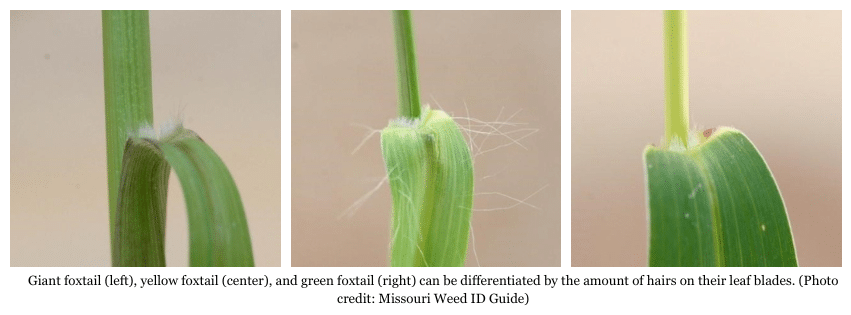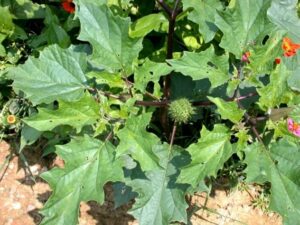Setaria faberi Herrm.
Giant foxtail is a clump-forming summer annual grass species commonly found throughout the United States in many agronomic crops, such as corn, soybean, canola, cotton, as well as turf, landscapes, fruits, and vegetables. It is considered one of the most troublesome grass weeds in North America.
Native to eastern Asia, giant foxtail was introduced in North America in the 1920s near New York City and was then found in Missouri in 1932. Since then, giant foxtail has spread and now it can be found in every state in the United States.
Giant foxtail grows well in sandy to loamy soils and in disturbed areas, and it is particularly problematic in the Corn Belt.
Similar Species
There are three troublesome species of annual foxtails (Setaria spp.): yellow foxtail (S. pumila), green foxtail (S. viridis), and giant foxtail (S. faberi). All three species have a seedhead that resembles a fox’s tail, hence the common names. All three species have the C4 photosynthetic pathway, which makes them very competitive with summer crops. Giant foxtail usually causes higher yield losses compared to the other two, but at high density, all three can reduce crop yield.

While yellow and green foxtails are palatable to sheep and have some forage nutritional value, giant foxtail is unpalatable. The foxtail plants tend to be more palatable when they are young, because as they mature the protein content decreases and the fiber increases. All foxtail species can cause problems for other types of livestock, such as horse and cattle, when they are mature, due to the bristly awns lodging in their mouths.

Identifying Features
Giant foxtail reproduces via seeds, which germinate from late spring through mid-summer from shallow soil depths; emergence is best from one inch or less. The upper leaf surface and leaf margins of seedlings are covered in dense short hairs. The leaf blades may reach 16 inches in length and half-to-one-inch in width. The stem grows upright and is round and hairless. Plants may grow to three to four feet in height. The seedhead is a cylindrical, bristly collection of flowers (a “panicle”) that droops (curves) as the seeds mature on the plant.

In the seedling stage, the presence or absence of hairs and their amount helps to distinguish the three species. The ligule of giant foxtail is a short fringe of hairs with the presence of short, fine dense hairs on the upper surface of the leaf blade the distinguishing characteristics. Yellow foxtail has a ligule formed by a fringe of hairs, and the leaf blade has sparse long, silky hairs on the upper surface of the leaf, near the leaf base and leaf collar. In green foxtail seedlings, the ligule is a fringe of hairs, and there are no hairs on the leaf blade.


In a mature plant, the seedheads of all three species resemble a fox’s tail, but their differences in size and color help distinguish between them and are the source of their common names. Giant foxtail has the largest seedhead and the only curved seedhead. Yellow foxtail has a cylindrical, bristly, upright panicle, and the bristles turn yellow when mature. Green foxtail has an upright, cylindrical seedhead, and the spikelets are green.
Seed Production
Flowering usually begins mid-summer for spring germinating giant foxtail plants, and they often continue to flower and set seed until the weather becomes cold. The potential seed production varies with the competing crop and environmental conditions. On average when competing with corn and soybeans, one seedhead from a giant foxtail plant can produce about 1,500 seeds.
Giant foxtail seeds do not have any special adaptations to enhance dispersal, The common methods of seed dispersal are contamination in seed grain, birds, irrigation water, and humans with farm machinery. Length of seed viability in the soil varies depending on the type of soil management; in tilled soil, experiments have shown few survivors after two years and no survivors after three years of burial.
Herbicide Resistance



Integrated Weed Management Options
Tillage practices can influence emergence. No-tillage practices favor giant foxtail because of its ability to readily germinate on the soil surface. As a result, one way to manage foxtail is to manipulate the timing and depth of tillage. Past research has shown few survivors after two years of seed burial and no survivors after three years.
Cover Crops may reduce weed density and may reduce competitiveness. Some research in no-till-planted soybeans showed that moderate to heavy cover crop residue was able to reduce the foxtails species density by 85% in the mid-Atlantic region.
Harvest Weed Seed Control is not a perfect fit for management of this weed because over half of the seeds of giant foxtail are released by the time of soybean harvest, which would prevent the seeds from entering the combine where they could be destroyed.
Crop Rotation including winter small grains is a good tactic that consistently reduces weed density and competitiveness. Fields with a high density of giant foxtail may be rotated with alfalfa for two years, and that will deplete the weed seed bank.
Chemical application of a residual herbicide at planting, using a timely postemergence application, and the inclusion of a soil residual herbicide with the postemergence application are excellent recommendations for controlling giant foxtail. The postemergence herbicides have to be applied in the seedling growth stage of giant foxtail in order to have good weed control. Because this is a grass weed, it is easier to control it in broadleaf crops than in corn for example.
Herbicide Control Options
Corn
Herbicides are an important tool to control giant foxtail in corn fields; however, foliar herbicides must be applied when the plants are small in order to have good control. Burndown herbicides that have good-to-excellent control on this weed are paraquat (Gramoxone) and glyphosate. Examples of good preemergence herbicide options are atrazine, S-metalachlor (Dual II Magnum, Bicep II Magnum, etc.), isoxaflutole (Balance Flexx), dimethenamid-p (Outlook), and pyroxasulfone (Zidua or Anthem products). Good postemergence herbicide options include nicosulfuron (Accent Q), topramezone (Armezon, Impact), and glyphosate.
Soybean
Giant foxtail is easier to control in broadleaf crops such as soybean, since there are more herbicide options with excellent crop selectivity. A good burndown herbicide option is glyphosate. Preemergence herbicide options are pyroxasulfone (Zidua or Anthem products), S-metalachlor (Dual Magnum), clomazone (Command), dimethenamid-p (Outlook), and acetochlor (Warrant). Postemergence herbicide options include clethodim (Select, Select Max), quizalofop (Assure II, Targa), sethoxydim (Poast), and glyphosate.
Small Grains
Giant foxtail can be problematic in spring wheat, and some of the preemergence herbicide options include pyroxasulfone (Zidua or Anthem products), and trifluralin (Trust). Postemergence herbicides pinoxaden (Axial XL), clodinafop (Discover NG), flucarbazone (Everest 3.0), and fenoxaprop (Tacoma) are good options.
Sorghum
Preemergence herbicide options for giant foxtail control in sorghum are S-metolachlor (Dual II Magnum, Bicep II Magnum), glyphosate, and dimethenamid-p (Outlook). Quinclorac (Facet L) is the only postemergence herbicide option in all sorghum varieties, but it must be applied when foxtails are less than 2 inches in height for effective control. Herbicide-resistant sorghum hybrids are effective postemergence options for managing giant foxtail. Inzen herbicide-tolerant sorghum, was developed for use of nicosulfuron (Zest WDG) which is effective if the giant foxtail population is not resistant to ALS-inhibiting herbicides. Double Team sorghum technology allows quizalofop-p-ethyl (FirstAct), and iGrowth sorghum technology which allows the application of imazamox (ImiFlex).
Resources
Take Action: Giant foxtail. https://iwilltakeaction.com/weeds/identification/giant-foxtail/ Accessed: April 15, 2024
Heap I (2023) The International Survey of Herbicide Resistant Weeds www.weedscience.org Accessed: April 15, 2024
USDA Plants Database. Setaria faberi Herrm. https://plants.usda.gov/home/plantProfile?symbol=SEFA Accessed: April 15, 2024
Citations
Buhler DD, Hartzler, RG (2001) Emergence and persistence of seed of velvetleaf, common waterhemp, woolly cupgrass, and giant foxtail. Weed Science, 49: 230-235.
Cornell Weed Identification. Agricultural Weed ID for New York State. Foxtail species. https://blogs.cornell.edu/weedid/foxtails/. Accessed April 15, 2024.
Dekker J (2003) The foxtail (Setaria) species-group. Weed science, 51: 641-656.
Getting Rid of Weeds (GROW). Weed of the Week: Giant Foxtail. https://growiwm.org/1387-2/#. Accessed April 15, 2024.
Joseph, Dwayne D. and Kerner, Leo. Know Your Foxtails (FS-2023-0658). https://extension.umd.edu/resource/know-your-foxtails-fs-2023-0658/
Marten GC, Andersen RN (1975) Forage Nutritive Value and Palatability of 12 Common Annual Weeds 1. Crop Science, 15: 821-827.
Michigan State University Extension. Giant foxtail. https://www.canr.msu.edu/weeds/extension/giant-foxtail. Accessed April 15, 2024.
Mirsky SB, Curran WS, Mortenseny DM, Ryany MR, Shumway DL (2011) Timing of cover-crop management effects on weed suppression in no-till planted soybean using a roller-crimper. Weed Science, 59: 380-389.
Mohler CL, Teasdale JR, DiTommaso A (2021) Foxtails. Pages 158-162 in Mohler CL, Teasdale JR, DiTommaso A, eds. Manage Weeds On Your Farm: a guide to ecological strategies. USDA-SARE Handbook Series 16 https://www.sare.org/resources/manage-weeds-on-your-farm/
Neal JC, Uva RH, DiTomaso JM, DiTommaso AD (2023) Weeds of the Northeast. 2nd ed. Comstock Publishing Associates; 608 p
Schwartz-Lazaro L, Shergill L, Evans J, Bagavathiannan M, Beam S, Bish, M, Mirsky S. (2021) Seed-shattering phenology at soybean harvest of economically important weeds in multiple regions of the United States. Part 2: Grass species. Weed Science, 69: 104-110.
University of Missouri Division of Plant Sciences (2021) Weed ID Guide: Giant foxtail. https://weedid.missouri.edu/weedinfo.cfm?weed_id=256. Accessed April 15, 2024.
Van Wychen L (2022) Survey of the Most Common and Troublesome Weeds in Broadleaf Crops, Fruits & Vegetables in the United States and Canada. Weed Science Society of America National Weed Survey Dataset. Available: http://wssa.net/wp-content/uploads/2022 weed survey broadleaf crops.xlsx
WinField United (2024) 2024 Crop Protection Guide Information for Dealers.
Author
Cristiana Rankrape, Southern Illinois University Carbondale
Editors
Emily Unglesbee, GROW
Karla Gage, Southern Illinois University
Mark VanGessel, University of Delaware
Michael Flessner, Virginia Tech
































































































